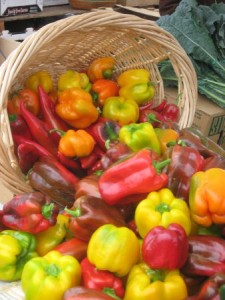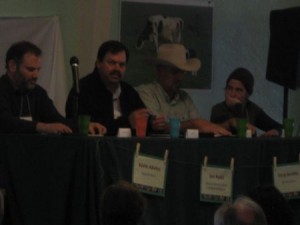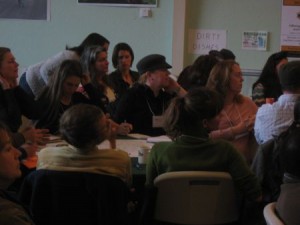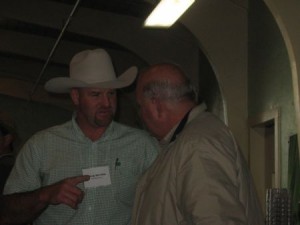Four farmers sat at my table during the Food Forum. Eleanor and Balyn run Wild Rose Farm, and I frequently buy vegetables from them. Across the table, a young woman whose name I never got said she farms about an acre and a half, and wants to add an additional half acre. She grows specialty vegetables. Deborah, who manages the Santa Rosa Junior College’s Shone Farm as well as her own, sat next to me. Each of them spoke with passion about farming and how they love it; and each of them had so many complaints about how awful it is that I wondered why they bothered.
I believe that they love it, though, and apparently they aren’t alone.
We’re Number Four
- California is the #1 agricultural producer in the country. We produce more than two times the amount of the second and third states combined.
- California supplies ½ of the nation’s fruits, nuts and vegetables.
- Internationally we are known for wine, cotton, almonds and rice.
Sonoma County is the third highest-producing agricultural county in the state.
- We are the third highest in number of farmers.
- We are fourth highest in agricultural sales, bringing in nearly $500 million in agricultural sales each year. Over $400,000 of that is due to wine grape sales. There are 1,500 grape growers in the county, 40% of whom have vineyards of less than 20 acres.
- Vegetables account for $7.9 million in sales, apples $1.3 million, and liquid milk (not counting cheese) about $64,000.
These statistics came from Paul Vosson who works for the University of California, Davis Cooperative Extension. Paul talked about Sonoma’s agricultural history; butter and eggs, prunes, hops, berries, figs and kiwi—crops we no longer sell. He applauded our foray into the specialty olive and cheese producing, and our tendency to “brand” our items as uniquely Sonoma County.
The morning panel comprised three farmers and one cheese producer who talked about their experience in the “food system.”
It’s Hard Out Here For a Farmer
Milk is one of the products that costs more to produce, especially if the dairy farmer supplements pasture feeding, which most do. Because of Sonoma County’s clay pan under the layer of rich topsoil, you can’t grow alfalfa successfully here. Alfalfa has to be trucked in. Our location, far from the Interstate 5/Interstate 99 corridors, means truck companies charge a premium. That gets passed on to the consumer. Water is costly, and most recycled water gets directed to vineyards.
Another high cost is labor.
Agriculture, like manufacturing, has a spotty history when it comes to treatment of employees. In 1965, Governor Edmund “Pat” Brown was calling for authority to import foreign (read “Mexican”) workers to pick fruit in the central valley field and South California orchards, because they could pay immigrant labor less than the Federally-mandated $1.40/hour agricultural minimum wage. Farmers could also wait until the end of the harvest and pay in one lump sum, which led to abuses, such as hiring immigrant labor illegally, letting them work the harvest, then making an anonymous call to Immigration a day before payday and having them all deported unpaid. This happened here in Sonoma with the prune orchards and early vineyards—I knew people whose families it happened to. Living conditions for field labor was and still often is horrific, like the working conditions. Each year at least one or two field laborers die in the fields in the Central Valley still, usually from heat exhaustion or dehydration.
To protect against these human rights abuses, labor laws and regulations are quite strict, but they take the cookie-cutter approach. The same laws that apply to the AgriBiz farm that hires 100 field workers applies to my table-mate with her acre and a half, who wants to hire a part-time person or recruit an intern. Since many people want to farm in Sonoma County, an intern program seems brilliant; but there are the legal obstacles to be overcome.
Even in the recession, Sonoma County has some of the most expensive land in California. It is very difficult to “break into” farming. Two of the panelists were third and fourth generation farmers whose families bought the land in the 1950s, or 40s. Land, infrastructure and equipment are all expensive; start up is a big risk for a young farmer. If you can’t afford to buy your land, and you can’t learn how to farm by working for someone else for a few years; you can’t afford health insurance, tractors, or hoop houses, just how do you get started?
Taxes Breaks in Limbo
The Williamson Act, which allowed lower assessment, and lower taxes, for the farmer and a “backfill” of state funds for the county, is in jeopardy because of California’s fiscal crisis. Governor Schwarzenegger did not eliminate the act but reduced the state money to repay the counties to $1,000 as a “placeholder.” The current governor is considering the complete elimination of the act. (See Comment below for more detail on the Williamson Act). The proposed change would increase property taxes on local farmers. The purpose of the Williamson Act was to encourage farmers to keep land used for farming and not be “tempted” to sell it to a developer. In Sonoma County, that temptation still runs pretty high, especially if there is a tax penalty for farming.
There is no “There” There
Once you grow and harvest your crop when it’s ripe, you have two or three days to get it to consumers. If you don’t farm the land you live on, you may not have a place to wash and bundle your goods. Even if you do, you may not be able to afford a contract with a distributor, especially if your crop is small and/or specialized. With the recession, Sonoma County’s wonderful inventive restaurants are buying less expensive produce they can get from southern California.
Local farmers and officials are getting together to talk about a “food hub;” a central place where produce can be “lightly processed” (cleaned, culled, bundled) stored, and distributed. There is interest from neighboring counties like Lake County with its pear orchards, and Mendocino. Food distributors like Green Leaf and Sonoma Organics would be willing to come to a food hub because they would get a payload that was worth their while. Some food hub models include an on-site farmers market and other features.
Richard Rominger sees locally-grown food as a better economic and security option. Food grown nearby does not use as much energy to get to the table, and it is less vulnerable to transport disruption. “Food security is a national security issue,” he said.
Waitin’ For a Train
Doug Beretta, a dairy farmer who talked about the cost of trucking in alfalfa, said that this county needs freight rail again, and he got a round of applause. There is work to bring back rail in Sonoma County, mostly commuter rail, running north-south. There is no reason freight trains couldn’t run on those rails, but I don’t see how the alfalfa gets here if there is no east-west rail as well. This is an interesting conundrum.
A Herd of Elephants in the Room
Some things we don’t like to talk about they make people uncomfortable. When it comes to the role of government, most farmers’ attitudes can be summed up in one sentence; “Give me the money and leave me alone.” According to the USDA, in 2009 the average Sonoma County farmer got $7,000 in subsidies. They want the county to step in and help them with labor subsidies, food hubs and trains, but Beretta flat out said that voters had no right to tell him how to run his business. “I don’t tell them how to do their jobs.” Compliance with regulations is too onerous, subsidies aren’t high enough, labor is expensive and tax breaks aren’t big enough. These are the complaints of every corporation in America. It’s no surprise that the Farm Bureau is primarily Republican.
Beretta also talked about farmers as champions of the environment in ways other businesses aren’t. You want riparian areas? You want the tiger salamander protected? You want a rare flower allowed to flourish? Talk to the farmers, those noble stewards of the land, who work with these things all the time. Many farmers are conscious of the environment now, and many do farm organically—Beretta is one—and many do reduce the runoff and limit pesticides. Some of that is because they are required to, or paid to, by the government; some of it is because “organic” is a marketing technique. It’s disingenuous to pretend that the farmers have protected the land when we know the national history of farming; pesticide and herbicide overuse, poisoned local streams and waterways. Ranchers might want to save the salamander but traditionally have not been interested in peaceful co-existence with any predator, including our national bird, the bald eagle.
It’s awkward to talk about what an environmentally filthy business growing winegrapes can be, though, when the Association of Wine Growers sponsored your forum.
That said, the challenges to food production, at least growing it, were clearly delineated. What’s a farmer to do? The panel had some ideas about that as well,which I will cover in the next installment.





The Williamson Act was designed to allow a farmer to develop new land for farming. When new land was purchased, the farmer agreed to use it only for agriculture for a ten-year period, and in return, the property was taxed at its production value, not its Fair Market Value. Each county determined whether newly purchased land could fit into a Williamson Act category. Since counties get most (not all) of the collected property taxes, the counties stood to lose revenue with this Act, so the state “back-filled” what the counties lost. In Sonoma County, that comes to more than $400,000 a year.
At the state capital, there is a real desire to get rid of the Williamson Act. California is teetering on bankruptcy, and a lot of decisions are being made with an eye to the short-term crisis. This is one of those. The non-partisan Legislative Analyst’s Office recommends getting rid of the Williamson Act because they see the law as primarily existing to keep farmers from being tempted to sell their land to developers. Sonoma is a desirable place to live and moneyed people will still pay premium prices to live here. The “pressure to sell the land for development” is a real thing for the third-generation dairy farmer who nets $12,000/year.